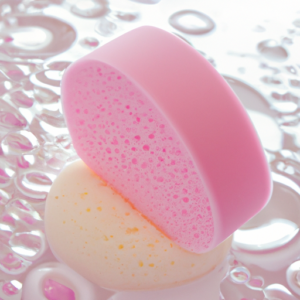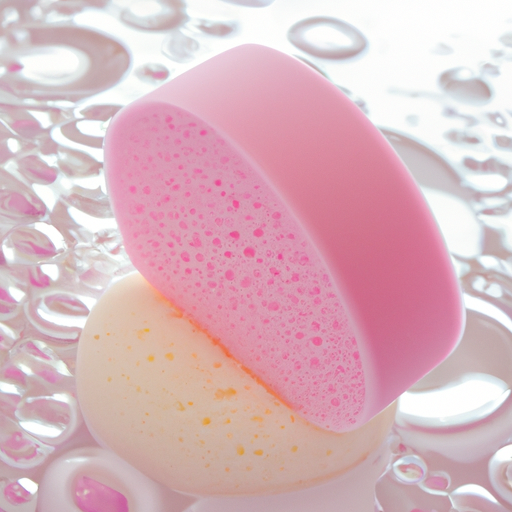Hey there! Let’s talk about sponges for your makeup routine!
Alright, so first things first. When we say “sponge for makeup”, we’re talking about those little spongey things that you use to apply foundation, concealer, or any other liquid or cream makeup product to your face.
Using a sponge for your makeup routine has a bunch of benefits! For one, sponges can help blend out your makeup flawlessly, giving you an airbrushed look. They can also help you apply your makeup more precisely, getting into the nooks and crannies of your face that your fingers or brushes might not be able to reach.
Types of Sponges: Synthetic or Natural?
When it comes to makeup sponges, there are two types: synthetic and natural. Synthetic sponges are made of man-made materials like latex and polyurethane, whereas natural sponges are made from sea creatures like sea sponges and konjac roots.
Synthetic sponges are more durable and easier to clean, making them a great option for everyday use. They’re also hypoallergenic, making them suitable for those with sensitive skin. However, they tend to absorb more product, so you may end up using more foundation or concealer than necessary.
Natural sponges, on the other hand, are softer and gentler on the skin, making them a good choice for those with dry or sensitive skin. They also absorb less product, so you’ll end up using less foundation or concealer. However, they require more care when cleaning and can harbor bacteria if not cleaned properly.

Ultimately, the choice of sponge material is up to personal preference and specific skin needs.
Choosing the Right Sponge
Now that you know the different types of sponges, it’s time to choose the perfect one for you. But with so many options available, it can be overwhelming to select the best sponge.
Firstly, consider your skin type. If you have sensitive skin, a natural sponge may be the better choice, as it is gentle and less likely to cause irritation. Conversely, synthetic sponges may be best for oily or combination skin, as they tend to absorb less product.
Next, think about the shape and size of the sponge. Some sponges are designed specifically for certain areas of the face, such as the under-eye or nose. Additionally, larger sponges may be better for applying foundation, while smaller ones are ideal for spot concealing.
Lastly, it’s important to take into consideration the sponge’s texture and density. A soft, bouncy texture can help create a natural, smooth finish. A denser sponge, on the other hand, can provide more coverage and help blend product seamlessly.
When purchasing a sponge, don’t be afraid to test it out in-store or online reviews to see how it works for other people. Finding the right sponge can make a world of difference in your makeup application and overall look.
How to Use a Sponge
Alright, now you’ve got your sponge! Here’s how to make the most of it. Before using a sponge, I always make sure it’s dampened. You don’t want to apply your foundation or any makeup on a dry sponge. I usually run it under some water and then squeeze out the excess water until the sponge is just slightly damp. When using a sponge, I like to start with applying my foundation. I usually place a dollop of foundation on the back of my hand, dab the sponge into the foundation, and then apply it to my face. To blend, I use a dabbing motion on my skin. A great tip to make sure your makeup is blended flawlessly is to use a bouncing and rolling motion while working with the sponge. You can even use the pointed area of the sponge to reach smaller areas where it’s harder to apply makeup.Also, remember to clean your sponge often! A dirty sponge can lead to breakouts and can cause the sponge to deteriorate faster. You can wash your sponge with soap and water or use a special cleansing solution.Now, you’re well on your way to achieving that flawless makeup look! If you’re looking for more tips and tricks, make sure to check out eyelashesholic.de for more expert advice.
The Final Word on Makeup Sponges: A Personal Take
So, that’s it! We’ve covered all the key points you need to know about makeup sponges. As someone who has been using sponges for years, I can confidently say that they are a total gamechanger for getting a perfect, flawless makeup look.
Firstly, let’s remember what sponges are and why we use them. Sponges are small, porous tools used to apply liquid or cream makeup to your face. They have become increasingly popular in recent years due to their many benefits – they help to create a smooth, flawless base, minimize product waste, and can be a great way to quickly apply your makeup.
When it comes to choosing a sponge, there are many factors to consider, from the type of sponge to the texture and shape. As we’ve discussed, synthetic and natural sponges each have their pros and cons, so it’s important to think about your personal preferences, budget, and the type of makeup you’re using.
Perhaps the most crucial aspect of using a sponge is how you apply your makeup with it. While it may seem simple, there are actually a few tips and tricks you should keep in mind to get the most out of your sponge. It’s important to prepare your sponge properly, either by dampening it or using it dry, and to use the right techniques for blending and buffing your makeup.
In conclusion, there’s no denying that makeup sponges are an excellent tool for any beauty lover. Whether you’re a pro or a beginner, they can help you achieve a perfect makeup look with minimal effort and maximum results. By keeping in mind the information we’ve covered here today, you’ll be well on your way to finding the perfect sponge and mastering the art of makeup application. Happy blending!
